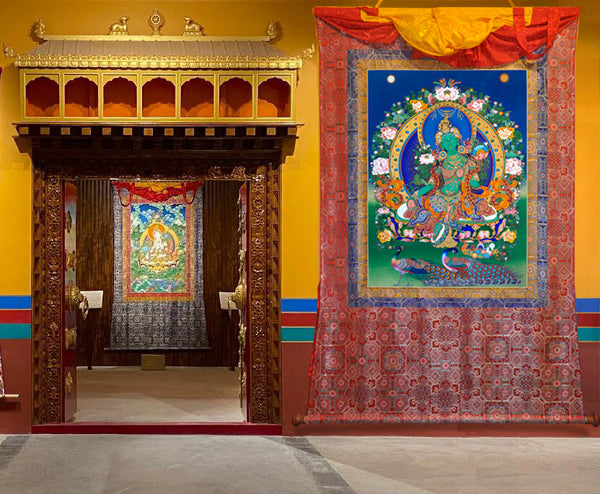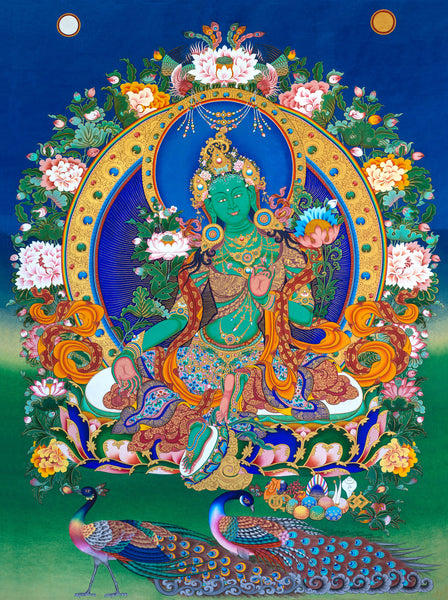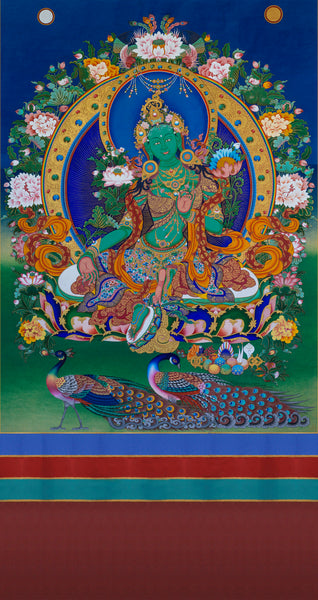4-5 Feet Dharamshala Tara (8-10 Feet with silk mount)
Image: Dharamsala Tara
Artist: Master Locho
DHARAMSALA TARA
1959 CE - 2020 CE
4 Years in Making ( 2017-2021)
This representation of the Green Tara brings our journey through the 2,300-year-old history of Buddhist art to the present day. Pulling stylistic inspiration from each generation and location, as well as symbolic inspiration from life in Dharamsala, this panting is an homage to the past, a celebration of present, and a contribution to our future.
Sarika Singh chose the female Bodhisattva Tara as the central figure of the series because she believes that they have a mutual relationship grounded by reciprocity. Sarika Singh is believed to be the only or one of the very few female thangka master in the world. In a field dominated by men, Sarika believes that Tara and the attributes she embodies have enabled her to thrive, have allowed her to express her gratitude to the practice, and share with the world the philosophy of Buddhism. As Tara is the ultimate mother and creator, Sarika emulates these qualities through cultivating this art form; devoting her life to advocating for its continuation and accessibility. Sarika lends her depiction of Tara dedication to every detail, beauty to every element, which exemplifies compassion, generosity, protection, selflessness, and love.
In this piece, Tara is draped in a long-sleeved flowing blouse, her long hair cascading down her shoulders. She is adorned in precious jewels, showcasing her beauty. She is surrounded by lotuses, leaves, and birds. Tara sits resilient and peaceful in her celestial abode. She is representative of the Tibetan people and the larger Buddhist community in India. The phoenixes that emerge from the fauna above Tara symbolize rebirth as they born again from ash. Just as the phoenix rises from the ash, Buddhist art has continued to develop and propagate throughout generations, geography, and cultures. Peacocks, the national bird of India, are an emblematic of celebration in their grandeur, cultural diversity and beauty. Two peacocks stand below Tara in her lotus bed, one looking forward towards the future, and one gazing behind, reflecting upon the past. The peacocks allude to Master Locho's and Sarika's conviction to preserve the thangka art form, contribute to its growth, and embody the present times in which it lives.
Occupation in Tibet since 1959 has led to the mass exodus of people forced to seek refuge in India. In a display of resiliency and testament to their nonviolence, the Tibetan people continue to work to keep their cultural identity, language, and belief system in the face of great adversity. When the Dalai Lama fled Tibet, among the possessions he deemed essential to bring was a Thangka painting, holding a strong belief for their beauty and power.
This image was conceptualized by both Master Locho and Sarika Singh. The painting was executed by Master Locho. The minerals used to create the colors of this painting are azurite blue, ultramarine blue, malachite green, cinnabar vermillion red, orpiment yellow, and calcium carbonate white chalk. In addition to these minerals, pure gold and silver are used as accent colors. These mineral pigments are mixed with glue and water to create different colored paints. As evidenced by the preservation of Thangka paintings from a thousand years ago, using this traditional process ensures the longevity of the painting.








